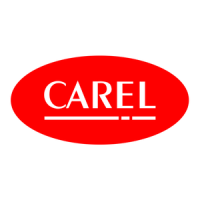ENG
“Power+” +0300050EN - rel. 2.3 - 08.06.2012 24
Mod.
add.
Description Def Min Max U.M.
100 Run/Stop (2 bit parameter)
bit meaning
0 0/1= stop/run
1 0/1=rotation in clockwise/
anticlockwise direction
00 4 -
101 Reset (3 bit parameter)
bit meaning
0 1= alarms reset and updating of
communication parameters
1 1= parameters reset at default values
2 1= reset ag check drive switch on
and switch o (see speed regulator,
bit2)
00 7 -
102 Frequency set point 0 Min
out
freq.
Max
out
freq.
0.1Hz
103 Autotuning 0/1=not active/start 0 0 1 -
Tab. 5.n
5.14 Status variables
The status variables are the read-only type and supply information regarding
the status of the drive (e.g. Modbus® = 104, drive in start, stop or alarm) or the
alarms present in the alarms code or other general information. For example,
with the bit of the status regulator it is possible to know whether the drive is
in a particular alarm status or protection, the status of the digital safety input
(STO) or the relay output.
The speed register signals whether the speed pro le has been completed,
if the speed automatic decrease function is active and with the relative ag
shows whether there has been a voltage black-out.
Other status variables inform regarding the drive temperature, current/
voltage/power supplied, the energy supplied in kWh and MWh, the voltage
and the voltage ripple on the DC bus, the number of drive switch-on hours
and the number of functioning hours with the motor running. It is possible
to know the motor electric data (stator/rotor resistance, stator inductance).
Regarding the characteristic data of the drive, the serial number, rmware
version and motor control version are available. For the complete list see
paragraph 7.3.
5.15 Modbus® Commands
The Power+ drive only uses Registers (16 bit), not boolean variables (coils).
The Modbus® functions implemented are:
Function number Function name
03 (0x03) Holding register reading
04 (0x04) Input register reading
06 (0x06) Single register writing
Tab. 5.o
The Modbus® exceptions supported are:
• exception 1: function not supported;
• exception 2: address not accepted;
• exception 3: value not accepted;
• exception 6: device occupied.

